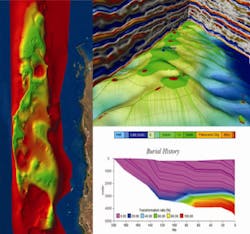Offshore staff
LONDON – Schlumberger has released the 2013 Petrel E&P software platform. The new version advances integration, multi-user collaboration, and applied science, said Schlumberger.
The release improves salt interpretation workflows, augments seismic imaging through pre-stack wide azimuth analysis, and improves links with Omega seismic data processing software.
The introduction of volume-based modeling supports representation of geological complexity to more accurately predict hydrocarbon accumulations. Geomechanical reconstruction validates interpretations in complex depositional environments. Further, geoscientists can now model 1D petroleum systems to determine charge maturity and risk, said Schlumberger.
The Petrel platform leverages advanced Schlumberger numerical simulators, which now include 3D geomechanical modeling of subsurface stresses, salt tectonics, and wellbore stability, providing 3D preproduction geomechanics and 4D modeling of producing fields. New production-analytics enable well performance analysis to diagnose production events and trends.
Petrel 2013 introduces what Schlumberger said is an improvement in software beta testing. The Petrel platform architecture now tracks and audits beta testing, so that each of the broad range of capabilities is consistently and comprehensively tested. More than 30 oil and gas companies participated, culminating in more than 20 man-years of testing.
The Studio environment for Petrel allows E&P experts to find all relevant data, collaborate with peers and share best practices in the context of their workflow. New indexing technology provides access to structured and unstructured data in Studio databases, as well as third-party applications and data sources.
6/11/2013



